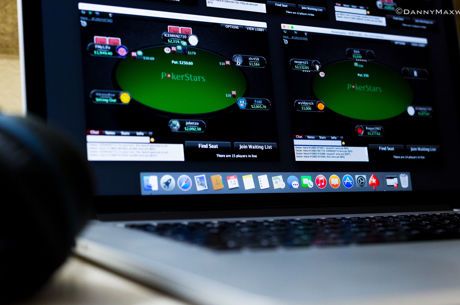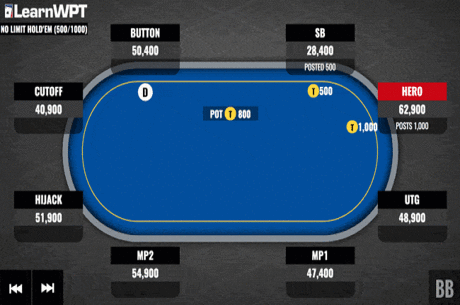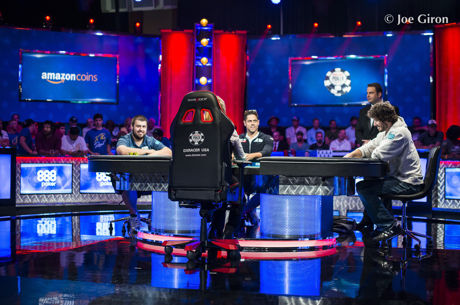Donk Betting in Small-Stakes Live No-Limit Hold'em
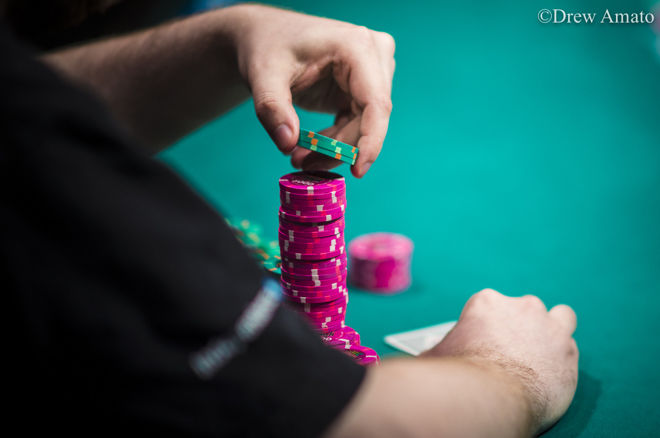
We have called a preflop raise but are out of position to the raiser. Conventional advice is to check to the raiser and let him continuation bet with his entire range. If instead we bet into the raiser, we are making a "donk bet." It sounds like a derogatory term, and it's meant to be. They don't call it a donk bet for nothing — donkeys do it all the time
The idea is that we will make more money by checking to the raiser (even when we hit the flop), since he will usually c-bet (even when he misses). Our donk bet lets him off the hook by allowing him to fold most of his misses. In the long run, we expect that checking will be our most profitable action.
Let's look a little more closely at this advice, in particular considering how it readily applies when playing online poker, but perhaps isn't so cut-and-dry when we move over to low-stakes live no-limit hold'em games.
Online Donk Betting Stats
We can start out testing the advice against donk betting by looking at some statistics from online NL50 and NL100. Figure 11 below shows the amount of profit Hero makes when he donk bets when given the opportunity to do so. In this case, Hero has called a preflop raise (CPFR) out of position to the raiser, and the chart shows what happens when he then donk bets the flop.
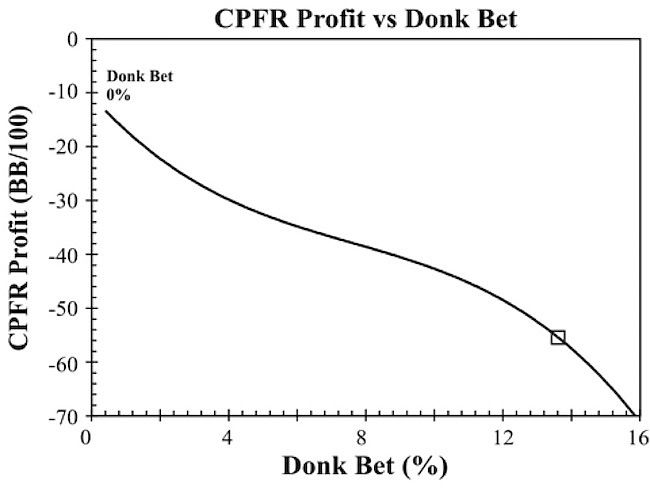
We can see that calling a preflop raise from out of position is unprofitable, even if we never donk bet. (We should generally either fold or reraise.) But it's clear that the more often we donk bet, the more money we lose. Indeed, donk betting a mere 14 percent of the time more quintuples our loss.
Some people have suggested that we should nevertheless donk bet in certain situations, and they go on to explain why. But regardless of the scenario they come up with, they can't explain away this online trend. If donk betting were optimal even 1 percent of the time, the curve would begin to bend downward near the 1 percent donk betting frequency.
Our conclusion should be clear: Never donk bet on the flop online!
Live Donk Betting
Should we extend this wisdom to Las Vegas low-stakes no-limit hold'em? Perhaps not. There are some major differences between online and live no-limit hold'em we should consider.
- Vegas players raise with a tighter range and call raises with a much wider range.
- Vegas players are typically more passive and less likely to bluff.
- Vegas flops have more villains.
- Vegas games have live reads that are never present online.
These factors (and others) might conceivably make a Vegas donk bet the best play in some situations.
Vegas Donkey Ranges
The average Vegas $1/$2 player raises only 6.0 percent of the time, compared to 8.5 percent online. Meanwhile the average Vegas $1/$2 player calls a preflop raise 28.0 percent of the time, compared to only 15.3 percent online.
Thus when playing the low-stakes live games we often face a raiser with a strong flop range and multiple callers with weak calling ranges. These callers will often donk bet themselves, especially when they are afraid of the flop texture.
Passive Villains
Vegas $1/$2 players are typically more passive and less willing to bluff than online players. This means that they tend to be less willing to continuation bet-bluff on the flop, especially in a multi-way flop. Since our reason for checking and not donk betting is that we expect the raiser to c-bet frequently, our rationale for checking is weakened when we think the raiser is passive.
Family Pots
Family pots are rare online, but very common in Vegas $1/$2 and $2/$5 games. The raiser is less likely to continuation bet-bluff when he can't reasonably expect everyone to fold.
The average online flop only sees 2.7 players per flop, so we are nearly always heads-up or three-way. The average online player c-bets about 75 percent of the time in a heads-up flop and about 65 percent multi-way, when he has position. Checking to the raiser makes perfect sense with this level of aggression, and we should exploit that by letting him c-bet his air.
But the average Vegas $1/$2 flop is much more crowded, with 4.0 players per flop. In fact, 27 percent of these flops have at least five players. Since Vegas flops typically contain passive players, the preflop raiser won't often c-bet bluff into more than two villains. Therefore we might consider value betting or donk semi-bluffing in the right situations.
Live Reads
Detecting a live tell can be a big reason to consider a flop donk bet. Suppose we call a preflop raise in the big blind with 7♣7♦ and notice an "interest tell" on the A♣K♠7♥ flop.
Normally we would check to the raiser, who very likely has an ace. We could check-raise with our set, but that looks very strong, and might slow down a weaker ace. Or we could donk bet — we expect that he will at least call, and we won't look quite so strong. But he might raise instead, creating a larger profit when the stacks are deep.
Suppose we had those sevens and the flop was A♣6♠3♥, and we notice that the raiser does not like the flop (a "disinterest" tell). Perhaps he is afraid of the ace.
The villain may well have a superior pair or overcards to our sevens, making our hand vulnerable to the next card. We don't want him to check behind, so we decide to donk bet and represent the ace. Of course, this sounds like a reasonable action. But a check-raise in this situation may make even more profit if we think the villain will auto-continuation bet. The key question becomes "will the villain c-bet his air?"
Flop Texture
Flop texture is a key factor in our decision to donk bet, especially in a family pot.
Suppose we call a preflop raise from the small blind with A♣2♣ and see a A♠K♥2♥ flop five-handed. We have flopped a strong hand, but the flop has flush and gutshot straight draws.
With a five-way flop, the preflop raiser is unlikely to c-bet with air, and would likely call a donk bet with an ace, a king or a draw. None of the villains are likely to bluff at this, and anyone who would have bet would likely also call our bet. So a donk bet for value may be our best play.
Donk Bluffing
We would generally not want to donk bet bluff into a large field, since the primary purpose of a bluff is to fold out all of the villains. But a donk bet semi-bluff can be a good option when one or two of the villains have already checked.
Suppose we see a four-way Q♣8♥2♣ flop with J♣10♣ in the cutoff. Two players check, with the preflop raiser on the button. We have a flush draw and a gutshot straight draw. A semi-bluff here may fold out the button, providing us with position over any of the first two players who might call.
Don't lose sight of what Figure 11 tells us — donk betting is generally not the most profitable play. This is likely true even in a Vegas $1/$2 game. But in the right circumstances, a donk bet might be just the ticket.
Also in this series...
- Low-Stakes Live Games Differ from Online
- Do You Play Too Many Hands?
- Are You a Position-Dummy?
- When Can I Take a Bathroom Break?
- Is Straddling a Good or Bad Play?
- A Preflop Question: Is Limping Lame?
- Maximizing Expectation When Betting For Value
- Maximizing Expectation When Betting as a Bluff
- Five Weak Reasons to Bet (and One Weak Reason Not To)
- Do You Have 'Jack-O-Phobia'? Playing Pocket Jacks in Live NL Hold'em
Steve Selbrede has been playing poker for 20 years and writing about it since 2012. He is the author of five books, The Statistics of Poker, Beat the Donks, Donkey Poker Volume 1: Preflop, Donkey Poker Volume 2: Postflop, and Donkey Poker Volume 3: Hand Reading.
In this Series
- 1 Donkey Poker: Low-Stakes Live Games Differ from Online
- 2 Donkey Poker: Do You Play Too Many Hands?
- 3 Donkey Poker: Are You a Position-Dummy?
- 4 Donkey Poker: When Can I Take a Bathroom Break?
- 5 Is Straddling a Good or Bad Play?
- 6 A Preflop Question: Is Limping Lame?
- 7 Maximizing Expectation When Betting For Value
- 8 Maximizing Expectation When Betting as a Bluff
- 9 Five Weak Reasons to Bet (and One Weak Reason Not To)
- 10 Do You Have 'Jack-O-Phobia'? Playing Pocket Jacks in Live NL Hold'em
- 11 Donk Betting in Small-Stakes Live No-Limit Hold'em

